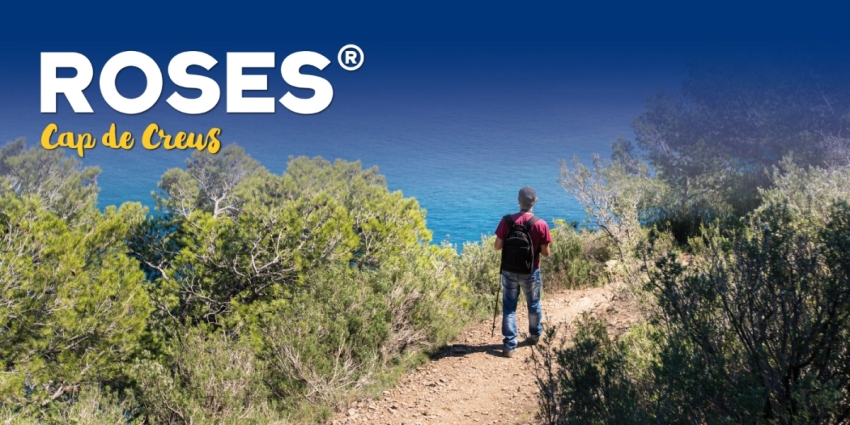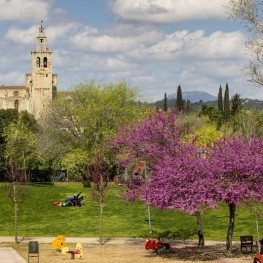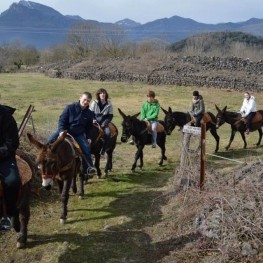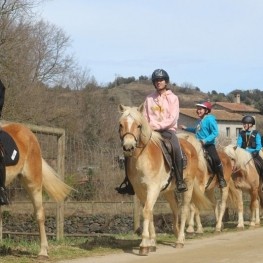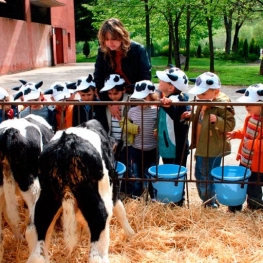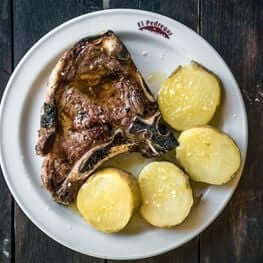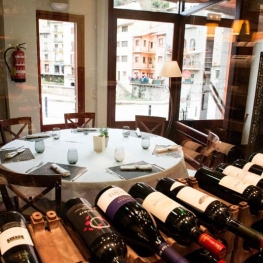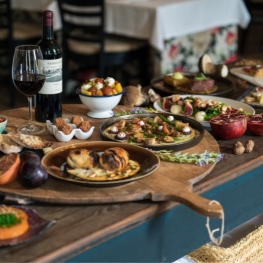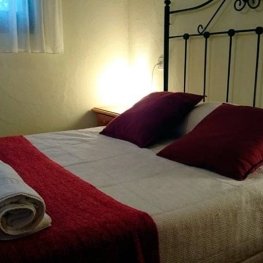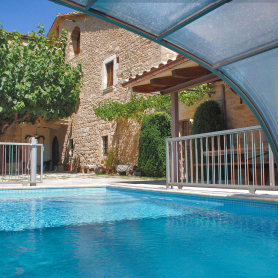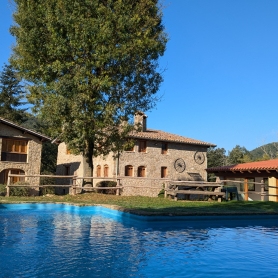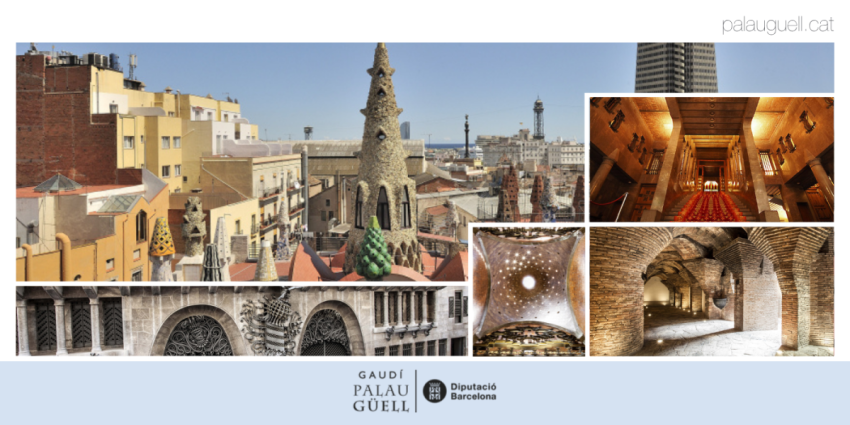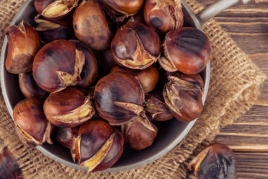Francesc de Verntallat, the path of the Remensas
This route takes us back more than 500 years ago, when many Catalan farmers subjected to conditions of slavery and certain feudal customs, known as misusos, rebelled against this situation by founding a union and taking up arms against the feudal lords.
Next, we will learn about its history and visit the places that are most closely linked to the remença leader, Francesc de Verntallat.
Francesc de Verntallat (1428 - 1499) was born in a farmhouse in the Vall d'en Bas, where this route begins. Near his farmhouse we can find elements that are related to the origins of Verntallat, a descendant of the Puigpardines lineage. That is why near the Mallol, and continuing in the end of the Vall d'en Bas, we find the church and the castle of Puigpardines and the Mas Toralles, former House of the lords of Puigpardines.
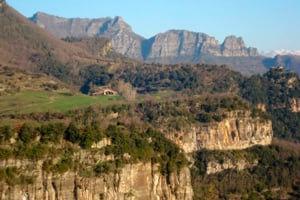 Verntallat was the most radical leader of the peasants in the fight to end the conditions of slavery and certain feudal customs. Feudal lords exercised excessive control over farmers and their families. Apart from the physical abuse they received, the farmers also had to pay extortionate taxes in order to work the lord's land. In this climate, Verntallat knew how to establish himself as the figure whom the peasants followed to achieve justice and freedom. He had the will and the ability to build a small army that allowed him to control much of Garrotxa and Guilleries.
Verntallat was the most radical leader of the peasants in the fight to end the conditions of slavery and certain feudal customs. Feudal lords exercised excessive control over farmers and their families. Apart from the physical abuse they received, the farmers also had to pay extortionate taxes in order to work the lord's land. In this climate, Verntallat knew how to establish himself as the figure whom the peasants followed to achieve justice and freedom. He had the will and the ability to build a small army that allowed him to control much of Garrotxa and Guilleries.
The Verntallat guerrilla grew rapidly. The peasants who joined their cause had the help of other peasants who stayed to work the land, with the promise of maintaining their crops for the duration of the war. This system of solidarity allowed Verntallat and the remensa to hold their own for many years, become strong and end up winning the war.
Another of the fundamental factors in the victory of the remensas was the alliance with King Juan II. Juan II was forced to go into exile in Aragon, and in his absence he left the mandate to his wife, the queen regent Juana Enríquez, who maintained the suspension of misuse during her regency, which served to win the sympathy of the farmers.. When the queen suffered a siege in Girona and Verntallat and his men went down to the city to help her, an alliance was strengthened that would be key to Verntallat's life and in the future of the war. The queen, grateful, made him captain royal. This fact formally signified the leadership of Verntallat. From then on, his followers were called verntallats.
When we go up to La Garrotxa through the inner jungle, we see the Castle of Hostoles. The castle was the center of remença power throughout the war period. After the fortification, it became an impregnable point for the enemy troops, and was always used as a place of safe retreat. So were the Castles of Puig-Alder and Colltort, which formerly marked the border between the counties of Besalú and Girona. It is located between the municipalities of Les Planes d'Hostoles and Sant Feliu de Pallerols.
In the Planes d'Hostoles we find the Hermitage of San Salvador, where years later the Castle of Puig-Alder would be built. On the other side of the road that connects Girona, Les Planes d'Hostoles and Sant Feliu de Pallerols, we find the church of San Pedro Sacosta. There is evidence that, as early as the 13th century, all the farmhouses in the parish were subject to misuse. In the Plains we also find Casa Jonquer, the cradle of an important Garrotxina saga of the time. In Sant Feliu de Pallerols we can visit the Conqueta mill, a flour mill mentioned for the first time in the 12th century. During the war it did not stop working to feed all the farmers. Currently the mill is municipal property and can be visited.
Near Santa Pau we find the Castle of Colltort, from where you can see the volcanic area of La Garrotxa. On this route we can also discover a couple of elements that, despite not being linked to the Remensa conflict, are well worth a visit. The first are the laundries of La Piña, in the Vall d'en Bas, exponents of a time when washing clothes became a very hard exercise, but socially conciliatory. And the second, the Sant Feliu de Pallerols Fair, where we can stop and enjoy a good time in the midst of the tranquility of the town square.
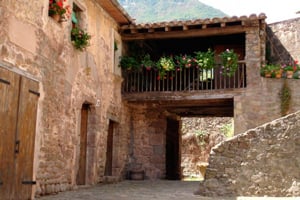 Verntallat falls back in the mountains around the castle of Hostoles as the remensas lose control of Besalú and Olot. In 1471, Girona surrendered to the pressure of Verntallat, who received vital support from the Finestres area, to the west of the Hostoles castle. The territory that today comprises the municipality of Sant Aniol de Finestres had a capital strategic importance in many armed conflicts in the history of Catalonia. The fact that it is a mountainous area with difficult access, close to Olot, Banyoles and Girona, made it a refuge for bandits. A good sample is the hermitage of Finestres. Closer to the inhabited areas, we currently find the church of Sant Esteve de Llémena and Sant Aniol de Finestres.
Verntallat falls back in the mountains around the castle of Hostoles as the remensas lose control of Besalú and Olot. In 1471, Girona surrendered to the pressure of Verntallat, who received vital support from the Finestres area, to the west of the Hostoles castle. The territory that today comprises the municipality of Sant Aniol de Finestres had a capital strategic importance in many armed conflicts in the history of Catalonia. The fact that it is a mountainous area with difficult access, close to Olot, Banyoles and Girona, made it a refuge for bandits. A good sample is the hermitage of Finestres. Closer to the inhabited areas, we currently find the church of Sant Esteve de Llémena and Sant Aniol de Finestres.
On October 28, 1472 the Catalan civil war ends with the victory of the monarchy with the help of the remensas. They hoped that the king would suppress the bad practices after the contribution of the peasantry in the victory, but this was not the case, and a period of confusion was entered.
Years later the conflict will reopen, but this time it will be a companion of Francesc de Verntallat, Pere Joan Sala, who will start the second remença war and who, after some victories near Barcelona, will be taken prisoner and publicly executed in Barcelona. Verntallat this time did not go to war but tried to negotiate, and ended up getting almost everything he wanted.
He presided over the remença delegation that signed the arbitration sentence of Guadalupe, in Extremadura, which puts an end to misuse, the right to mistreat and other abuses that were legal until then. After the sentence, Verntallat resided at court and was in contact with relevant figures such as Christopher Columbus. Later he retired to Sant Feliu de Pallerols where he lived in Mas Claperols. Today we can find a statue that remembers him. In the region we also find many other elements that make memories: schools, streets and establishments show that Verntallat is a loved and remembered character.
The legend of Francesc de Verntallat
Legend has it that Francesc de Verntallat was a fierce warrior, a great strategist and had an indomitable character. One day when he was with his men on the mountain, something made him angry. He took his sword and with a single blow cut an alder (vern in Catalan) in half. Since then he was known as Francesc de Verntallat.
You may also be interested in: Meet the famous Catalan characters
What to do
Rucs i Someres
Les Preses (a 3 Km)Rucs i Someres is dedicated to organizing tourist rides on Catalan donkeys…
Granja de cavalls i ponis, eQuillet
La Vall d'en Bas (a 6.3 Km)At the eQuillet Equestrian Club, we offer a wide range of activities…
Where to eat
Braseria Les Comes
L’Esquirol (a 11.2 Km)Located on the premises of the Anigami Adventure Park, they offer menus…
Restaurant el Pont 9
Camprodon (a 17.6 Km)A restaurant serving humble and simple cuisine, where you can enjoy the…
La Santa Restaurant
Ribes de Freser (a 29.8 Km)Our fires cook KM0 food obtained from the earth using traditional methods.…
Where to sleep
Apartaments Entre Volcans
OlotModern and well-located accommodation in Olot, with an indoor pool and spa…
Càmping la Fageda
Olot (a 3.6 Km)The bungalows consist of two bedrooms, a bathroom with shower, a fully…
Can Xargay
Porqueres (a 12.5 Km)Can Xargay is a charming, ancient Catalan farmhouse from the 11th century,…

